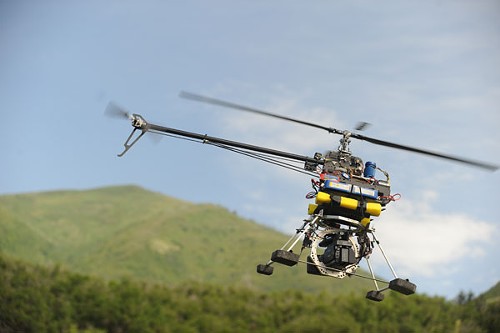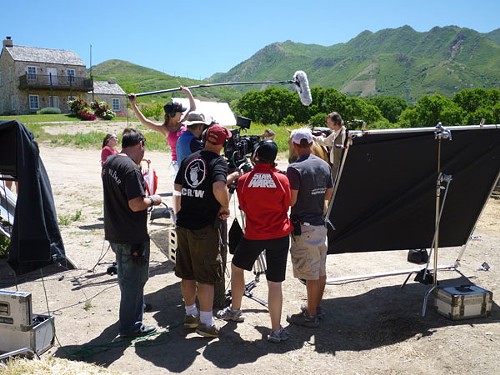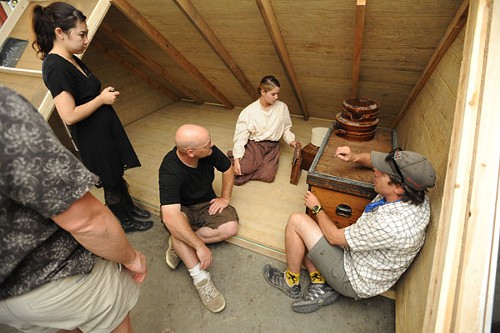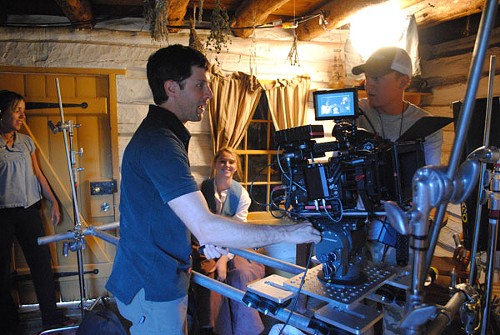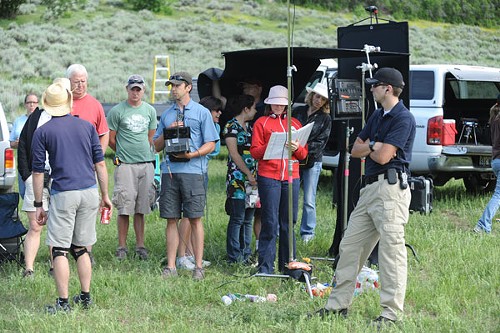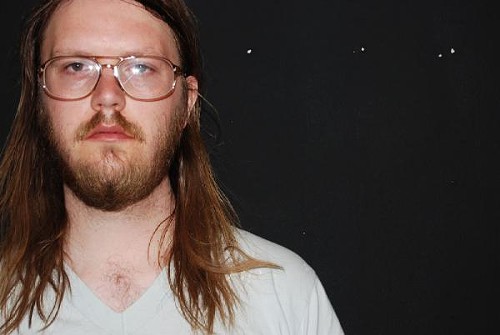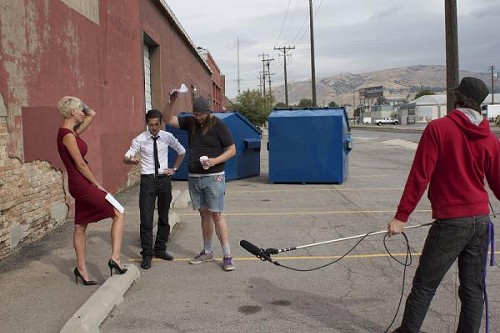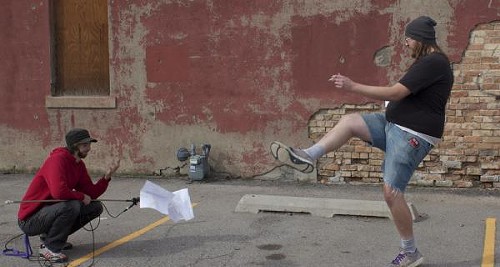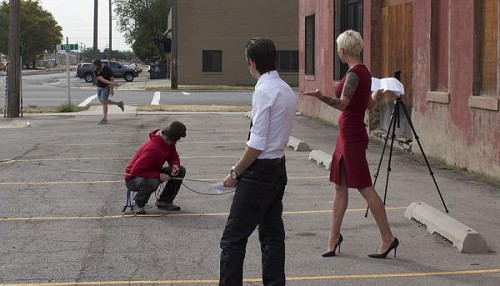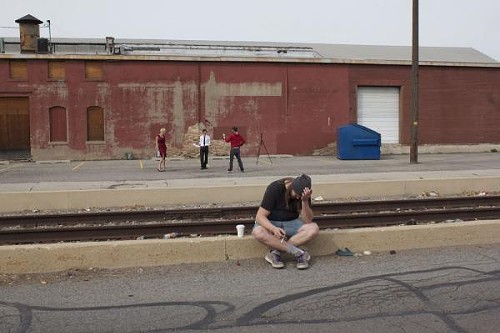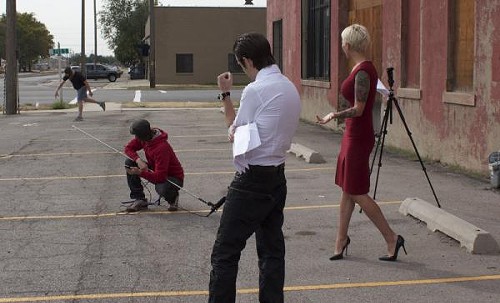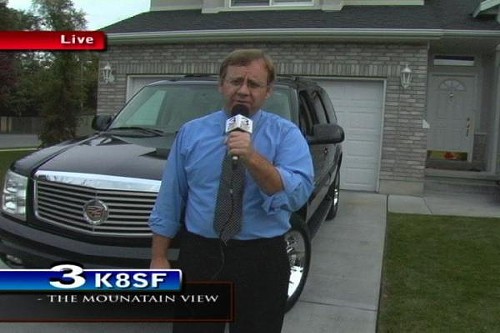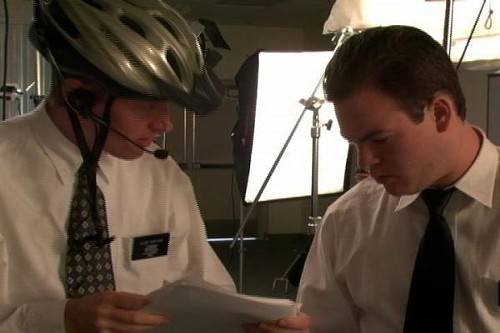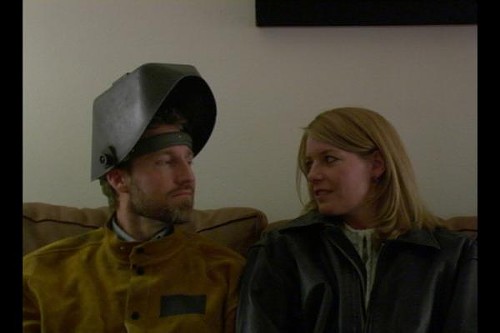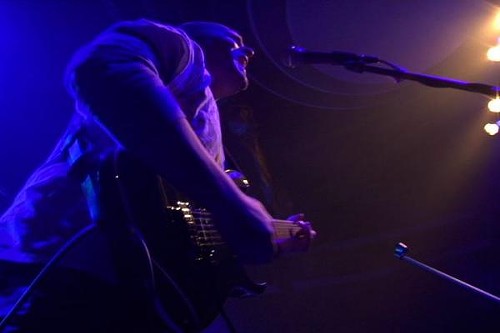Tuesday, October 19, 2010
Tower Theater's Open Screen Night Winners: September 2010
Posted By Gavin Sheehan on October 19, 2010, 1:45 AM
Last month after a brief hiatus for the summer, the Salt Lake Film Society held the third (Arty winning) Open Screen Night at the Tower Theater for 2010. A good number of entries came out this time to a packed crowd, you could definitely tell people had been hard at work over the summer. Your usual mix of material could be seen, upstart directors, college projects, random entries from 48 Hour, and groups looking to make a name for themselves locally. After all the films were play at the votes were tallied we came out with three very different winners. Chris Adler took home the Critic's Choice Award for his project "Reco", P.M. Baird was picked by the crowd for the Audience Choice Award for his film "The Future-er", and Lee Gardner was picked by the Society as the SLFS Choice Award winner for his project "Simple Inquisition". --- I got a chance to chat with all three winners about their careers so far, the films they made and their take on winning, plus their thoughts on localized cinema.
Chris
Adler
http://www.recinema.com/
Gavin:
Hey Chris. First off, tell us a little bit about yourself, and how
you got into filmmaking.
Chris:
I’m probably the most generic demographic of filmmaker there is.
I’m a computer programmer (nerd) who’s trying to make the full
time transition into film but I have to pay the bills with a
full-time
job I don’t really want to do. I’ve always been fascinated with
the process of filmmaking. When I was younger my oldest brother shot
some really cheesy movies on 8mm. but I thought what he did was
pretty awesome. So I started out by shooting some videos with my kids
and some of the neighbors. Those gave me a chance to learn the basics
of filmmaking in a fun non-threatening way. They weren’t the run of
the mill home video that goes straight from the camera to a VHS tape.
These were loading with effects really cheesy soundtracks. They
always seemed to end up with the kids being cast into corny adult
roles.
Gavin:
What films and directors would you say had a big influence on
you?
Chris:
Well, if I’ve seen your film, then you’ve influenced me in some
way—good or bad. I think everything we take in becomes part of our
individual thought process and is ultimately the basis for forming
the way we see and shape and express things. As far as analysis goes,
I’m fascinated with Stanley Kubrick’s work. There’s always
something behind the scenes in play that you aren’t consciously
aware of, but it’s there and begging to be discovered. I think the
most effective filmmakers are compelled to share their views and
opinions on issues we face as a society, but the smart ones hide it
deep in the story and leave it up to you to discover. And hopefully
never in an obvious way. John Hughes is another writer/director who
really had things worked out. Everything he did during the eighties
had an impact on me in some way.
Gavin:
Did you seek out any college for film, and if so, what was that
experience like for you?
Chris:
I didn’t, but I think it would have been a blast. I think film
school can be a great networking tool for a filmmaker, but it’s so
much cheaper to pick up practical experience on a set. There are
always local productions going on that drool over free labor. I’m
totally jealous of places like East Hollywood High and wish I had the
chance to experience a program like that when I was in high
school.
Gavin:
Do you prefer working as an independent filmmaker, or rather work
with a group and form a production?
Chris:
In my opinion you have to be able to do both. I think coming up with
a cohesive and effective story isn’t a democratic process. So in
the development phase you really need a strong single voice driving
the process to get the story down on paper. At that point, you’re a
fool if you don’t surround yourself with people smarter than you to
make everything else happen. I think directors that keep their ideas
close to their vest and are so fixated on getting exactly what they
see in their minds eye onto the monitor are really missing out. I’m
part of a local filmmaking group called ReCinema that subscribes to
that belief. Filmmaking is a collaborative process, and the more you
can improve your movie during the most cost effective phases the
better. Pixar is our inspiration as a model that works for animation.
We’re trying to make that model work for live action as
well.
Gavin:
When did you get involved with ReCinema and how has it been for you
working in that collective?
Chris:
ReCinema was hatched by Clayton Farr and Kyle Mallory (one of the
founders of the MPAU). Once they came up with some general ideas of
what they thought they’d like to experiment with, they began
looking for people to join the “brain trust”. So a few local
writers and myself thought we’d give it a try. ReCinema is
definitely an experiment that will improve with age. The fundamental
question we ask during nearly all of the phases of filmmaking is “is
this process really the best way to get this task done?” Just
because a studio or a dozen books tell you that one particular way to
do something is better than another doesn’t necessarily make it so.
That’s one of the things that attracted me to ReCinema—the fact
that I love to challenge and question nearly everything I observe.
Ultimately a lot of the processes we ended up using to produce "Reco"
turned out to be tried and true processes that nearly all other
filmmakers use, but not necessarily in the same order they use
them.
Gavin:
How did the concept for “Reco” come about?
Chris:
That’s an interesting question. Originally I kind of stole the
idea from another one that was floating around the ReCinema group.
That story was about a woman living an isolated life out in the
wilderness when all of a sudden a stranger winds up on her porch. The
guy’s almost dead. She nurses him back to health and during that
process discovers he’s the man who’s responsible for the death of
her husband. What does she do? I liked some of those elements, but
somehow in my mind I ended up changing the situation to exploring
what would happen if an independent teenager confronted her mother
about abandoning her as a young child. That story probably happens in
real life daily in the modern world, but that would have been too
easy and boring of a story to tell, so I placed it in the mid to late
eighteen hundreds to add some texture to the story. So, in place of
riding a subway to her birth mother’s house in an apartment in
Queens, Annie rides her horse “Reco” on a day’s journey to
confront her mother in a one room log house in a beautiful meadow.
The essence of both stories is the same. The story is about what the
mother and daughter experience and how they react, not where they
experience it and how they got there. That’s just eye
candy.
Gavin:
How was the experience for you in doing both initial casting and also
finding the locations to film at for this particular piece?
Chris:
Casting was a blast! We saw a really great pool of talent from the
local area and had a hard time choosing our final actors. Ultimately
we ended up with some great actors who really took their roles
further than expected. For locations, we spent a lot of time and had
to scout numerous places to find what we needed. We shot all of the
interior house shots and barn shots at “This Is The Place Heritage
Park”. We were able to shoot the house with very little set
dressing and that really save us a ton of money and effort. We ended
up having to build a set for the loft scene since we couldn’t find
anything appropriate that we could light and shoot. Nearly all of the
exterior scenes were shot high in a mountain meadow in Spanish Fork
on a massive horse ranch.
Gavin:
What was it like on set during filming? And how long did it take you
to film and then edit it up?
Chris:
Shooting was a blast! It was a really aggressive project because of
the budget and the number of locations and logistics of a few company
moves. The only reason we actually made our schedule was that we had
an talented pool of professionals making the magic happen. Everyone
was organized and really great to work with. We didn’t really run
into any big “situations” that we couldn’t work through fairly
easily. "Reco" was a four day shoot, though we could have used five or
six easily. Editing took around three weeks.
Gavin:
Were there any difficulties that came up along the way or was it all
pretty smooth?
Chris:
Well, "Reco" had every element that smart people caution filmmakers to
avoid in a film: children, animals, effect shots, and a period
setting! On top of that, one full day consisted of exterior shots in
a meadow down in Spanish Fork canyon so we were very dependent on
good weather. That day included some aerial shots captured with a
large radio controlled helicopter following our riding double running
away on horseback. We lucked out that the weather held out as long as
it did for those shots, but then it turned ugly and we lost a lot of
time. We actually got to a point where we decided to grab some great
rain shots and sent our riding double out in a torrential downpour to
ride around the meadows. Some of that footage is gorgeous and a few
of the shots made it into the final cut. Angel (the horse) was a
civilian, not a “Hollywood horse”, but she did a great job. The
only problem we had with her was after the storm a horsefly kept
biting her in the middle of nearly every take. We ended up having to
scramble to get some pick up shots later on and in another area that
had fewer flies.
Gavin:
Did you show the film to anyone prior to the event, and what did
they think of the film when it was finished?
Chris:
Actually we did some “test screenings” to select people as we
tried variations of the edit. Some of the elements we thought would
play well and be obvious to a viewer didn’t translate as well as we
hoped for, so we had to make some adjustments. Overall we received
great usable feedback and responses from everyone and have come up
with a final cut we’re all proud of.
Gavin:
How did you hear about the Tower Theater's Open Screen
Night?
Chris:
One of the members of ReCinema actually knew about it and we saw it
as a great opportunity to screen the story and gather some crowd
feedback. If you can play well at “Open Screen Night”, you’re
off to a good start!
Gavin:
What was it like seeing it there and hearing the audience
reaction?
Chris:
Actually it was really good seeing it in that venue. One of the
things we paid attention to is how it will be presented to the
audience. We’ve seen "Reco" projected on a digital cinema system with
the state of the art projectors and sound systems, and seeing it in a
more traditional venue like the Tower Theater was great. The audience
during Open Screen Night is honest and doesn’t hold anything back,
which is great feedback you don’t usually get when screening a
movie.
Gavin:
At the end you won the Critic's Choice Award. How did it feel winning
that and receiving that recognition?
Chris:
It was great. This was the first feedback we received from a real
critic so it was a real shot in the arm. Hopefully the festivals
we’ve entered will be as kind.
Gavin:
Going local, what’s your opinion of the local film scene, both
good and bad?
Chris:
Well, I think Utah is a great place for filmmakers. We have great
settings and stunning locations to shoot in and there are plenty of
people to crew up a film. "Reco" had a decent budget for a short, so
maybe we had it easier than some shorts find great crew, but I’ve
worked on some local shorts that were no budget and still had
competent crew on set with professional equipment. I really have
nothing bad to say about the film scene at all from my perspective.
Now, I’m sure if I was an actor I’d be telling a different
story.
Gavin:
Is there anything you think could be done to make it more
prominent?
Chris:
Incentives can always be improved, which would help. I think we have
the facilities to support pretty much anything that shoots here. We
have the scenery and locations. I think we need more of the local
small filmmakers to think bigger and step up and get real funding for
their projects, add some recognizable talent to their films, and
shoot them in Utah! We shouldn’t sit around and wait for a studio
film to come. Studio films go wherever the money and logistics of the
project drive them and I don’t think we can really control that.
It’s depressing that the great local actors we have usually end up
migrating to California so they can work. It would be nice if we
could keep them here.
Gavin:
Are there any local directors you feel are at the top of their
game?
Chris:
Good question. I haven’t really been exposed to a lot of the local
directors so I can’t really comment. I’m sure there are.
Gavin:
Do you know what you’re doing for your next film, and what can we
expect from you the rest of the year and going into next?
Chris:
I’m really excited about a thriller/horror story at the moment and
hopefully if you ask me in a year what I’m working on it will be in
the middle of shooting that.
Gavin:
Is there anything you’d like to promote or plug?
Chris:
Well, if course I hope everyone gets a chance to see "Reco". And keep
your eyes on ReCinema. There are several projects in the pipeline
there that are quite tasty.
P.M.
Barid
Gavin:
Hey P. First off, tell us a little bit about yourself, and how you
got into filmmaking.
P.M.:
I’ve wanted to make movies since I was a kid. I was raised by
artists and always had an appreciation for art in whatever form. Like
a lot of people, film had a big emotional impact on me - from
skateboarding around with a broomstick after I first saw “Teenage
Mutant Ninja Turtles,” to having a suddenly passionate interest in
my Scottish heritage after “Braveheart.” When a movie is really
good, you can just feel it. So Film quickly became, in my view, the
highest art form. So I wanted to do that.
Gavin:
What films and directors would you say had a big influence on
you?
P.M.:
Paul Thomas Anderson is the best that has ever been, as far as I’m
concerned. He hasn’t made anything that was less than amazing. Jean
Luc Godard is maybe the most important. And of course: Kubrick,
Malick, Scorsese, Soderbergh, The Coens, Kurasawa, Tarantino, Hawks
("Rio Bravo" is one of the best of all time), Bergman, etc, etc, etc.
This could go on forever. Corman, Wes Anderson, Erroll Morris,
Speilberg, Coppola (Francis and Sophia), Spike Jonze, David
O’Russell. A movie that is not very well known that is one of my
most recent favorites is “Ballast,” a gorgeous, sad little movie
that was top to bottom independent. I can't forget Orson, although
the way he handled his career might have more of an influence on me
than just his filmmaking.
Gavin:
Did you seek out any college for film, and if so, what was that
experience like for you?
P.M.:
Someone said “Film is the last oral tradition,” so I studied
that way. You can see everything, hear everything; it’s all there
for you to absorb. I’ve just tried to be as "absorbent"
as possible. You can learn tricks from almost any movie, then when
you start to actually make movies you learn a lot real quickly. I
recently watched Tom Ford’s "A Single Man," which was
just okay for the most part, but the cinematography was amazing! It
probably didn’t hurt that it was shot on the same discontinued
stock that my favorite movie of all time, “Magnolia” was shot on.
They did this trick with the color, that I’ve never seen before and
it was one of the best tricks I’ve seen in a long time. With
digital going places that film isn’t capable of, there is plenty of
room for new ways and methods. Everything has not been done before;
we just have to figure out how to do them. The Canon series are the
new Arriflex. They’re the game changer. It’s time for the next
level.
Gavin:
Do you prefer working as an independent filmmaker, or rather work
with a group and form a production?
P.M.:
I've been mainly a painter and photographer up until now. So It was
only recently, when I started making movies, that I’ve had to rely
on others to produce work. It has it’s ups and downs but for the
most part I’ve made some really good connections. It’s a real
honor to have people commit to something voluntarily. Also it’s
nice that most of them have a great amount of patience and
understanding. I’m learning, so I’m making mistakes, doing
re-shoots, etc., and it’s real nice to have people's understanding.
I think the goal of any filmmaker is to make good enough work
independently and then get a chance or two at final cut on larger
projects. I can’t really see myself not being in charge of
something I’ve written and intend to direct. I’ve got some other
projects that I’m going to be working on that I won’t be at the
head of. So I’ve got to continue to get better at working "from
the neck down," as a filmmaker friend of mine says.
Gavin:
How did the concept for “The Future-er” come about?
P.M.:
When I sit on my couch and watch a movie on the TV there is this
reflection in my computer monitor of my bedroom door and I’ve
always thought it would be super scary if I looked over and saw some
silhouette standing there. The funny thing is, that shot turned out
to be super hard to shoot, so it ended up not being in the movie.
Then I just had to fill in the blanks. Also, I was having trouble
finding actors for my other scripts so I decided I would just put
myself in it. I just wanted to make something.
Gavin:
What was it like on set during filming? And how long did it take you
to film and then edit it up?
P.M.:
I had some pre-production help and did some shoots with a few
friends on set. Then I would see that work and figure out what didn’t
work and re-shoot it. So there are actually only two brief handheld
shots in the final film that I didn’t shoot. It was the middle of
summer and it had to be shot at night, which wasn’t until like
9:30PM, so it was hard for people to be available. I ended up shooting
pretty much the whole thing by myself. I would shoot and then
re-shoot and that went on for maybe a month. Then I spent a good
month or so editing. So it was pretty relaxed on set. I only blew up
at myself a couple of times. My wrath was mostly suffered by
inanimate objects on this picture.
Gavin:
Did you show the film to anyone prior to the event, and what did
they think of the film when it was finished?
P.M.:
Yeah, I showed it to the people who attempted to help me out and to
my family. It was well received across the board. It was also nice to
see that those people who had read the script still gave the
responses I was hoping for, despite that they knew the story and all
the particular moments beforehand.
Gavin:
How did you hear about the Tower Theater's Open Screen Night?
P.M.:
I know all the kids who started it up, and I had been to a few of
the previous ones. It’s a good thing, as Martha Stewart would
say.
Gavin:
What was it like seeing it there and hearing the audience
reaction?
P.M.:
It was a strange experience. They showed it last and it was a pretty
long program, so there was a lot of anticipation for me. Then it
finally came on. I’ve watched the movie probably fifty-sixty times
or more, what with editing it and showing it to people. But when it
came on the big screen it was like everything sped up and it was only
on for like three minutes. It’s an eight and a half minute movie.
The response was everything I had hoped for, though.
Gavin:
At the end you won the Audience Choice Award. How did it feel
winning that and receiving that recognition?
P.M.:
I didn’t know there was an Audience Choice Award, so I’m really
happy about getting that one. If I had a choice that’s the one I’d
choose. You have to do the work for yourself and then hope that
others will get it. I couldn’t be more pleased with the award. Hugs
and kisses and thanks to everyone who voted for it and me.
Gavin:
Going local, what’s your opinion of the local film scene, both
good and bad?
P.M.:
I can’t speak too much on that. I don’t belong to any groups or
even roam in any circles. I know there are a handful of old-schoolers
and a handful of kids doing some work. There are the church movies.
They're really the only ones that get any type of distribution, and I
don’t have much interest in church movies, so I don’t see a great
deal of local stuff. Then there is the fact that we’re still just
Hollywood’s bitch.
Gavin:
Is there anything you think could be done to make it more
prominent?
P.M.:
I think the people that are here doing good work just need to start
getting recognized. Even though I haven’t seen much of the film
that is being done locally, I know people are doing it. There are a
lot of people doing different and good work here. I think Salt Lake
should be a more significant spot on the map.
Gavin:
Do you know what you’re doing for your next film, and what can we
expect from you the rest of the year and going into next?
P.M.:
I’ve been shooting my next picture for the past month and a half
or so. It’s beautiful so far. It’s an homage to Jen Luc Godard
called “Some Time With Her.” It’s been a learning process. I
know what I want and my visions are really clear. I just have to
figure out how to be more efficient and clean in getting them. I’m
wearing a lot of hats and kind of just getting by as far as equipment
goes. I also have no money to speak of. Luckily, as I mentioned
before, I have a handful of patient dedicated people who are really
making it happen. Then I’m going to start on a project with a
friend of mine, Brian, who has been one of my head guys on this
production. I’m also cutting a feature movie for Tobijah Tyler.
He’s been in the business a long time and this is his directorial
debut project, which he has also written, starred in, and done the
music for.
Gavin:
Is there anything you’d like to promote or plug?
P.M.:%uFFFD%uFFFD“The Future-er," of course, which I think I’m just going to put up on the internets. My next picture, “Some Time With Her.” Tobijah’s picture, called “Slice To Life.” Hopefully you’ll be able to see that some time next year. He’s hustling trying to get the money to finish it right. Brian’s picture, which I’ll be producing, has the working title of “A Million Seconds A Minute." Lastly I'd like to thank everyone who has helped me out and continues to help me out. It means the world to me.
Lee
Gardner
Gavin:
Hey Lee. First off, tell us a little bit about yourself, and how you
got into filmmaking.
Lee:
I was born in Provo, but at a young age my family moved to
Sacramento, California. I lived there until the summer of 2000 when we moved
back so my wife could be closer to her family. My father was an
independent filmmaker, which had a lot of influence on me. I often
helped on the sets of his film projects where I could. I watched my
father struggle to get his films made and distributed but when they
didn't move forward, I gave up on the idea of filmmaking for myself.
I thought, what chance do I have when someone so talented is having
such a hard time in the business? So I put it the dream aside to
pursue a career in computers. For years I kept saying that I could do
better than a lot of films I was seeing and it was time to put my
money where my mouth was. So I bought a Prosumer camera (DVX100),
borrowed a microphone and went to work writing and shooting some
short films. I had so much fun that after I finished my first short
film that I knew I would have to work to change careers to
filmmaking. It was a humbling experience to see I was falling short
in so many aspects of the filmmaking process. I gained a deep respect
for those who make films and do it successfully. I wanted to be
better and so I bought a bunch of books and started working on every
aspect that I could. Comparing and analyzing what I created to help
target areas I could improve. The end goal for me is to make feature
films. I love movies. I love how they transport me to a place for an
hour or two and take me on so many journeys that take me inside
myself and to other worlds. I hope to be able to do the same for
others.
Gavin:
What films and directors would you say had a big influence on
you?
Lee:
There’s so many but I would say my favorites are Ridely Scott,
Michael Mann and John Hughes. They have made so many films that have
enjoyed and that have greatly affected me.
Gavin:
Did you seek out any college for film, and if so, what was that
experience like for you?
Lee:
I didn't but I wish I had. One of the biggest things I feel I missed
out on by not attending a film school was the networking. For me,
it's been hard to find technical people, who are at a similar level
of experience and who have a thirst for making films, at least for
low to no budget films. My training comes from the small library of
books I have purchased over the years, watching every behind the
scenes I could get my hands on, the lectures from Fox Search Lab and
watching and analyzing movies made by masters of the craft. It also
comes from doing. You can read books, watch movies and listen to the
professionals tell you how to it but you will never learn more than
if you go out and try for yourself.
Gavin:
Do you prefer working as an independent filmmaker, or rather work
with a group and form a production?
Lee:
I don't think I have a preference. I love working with people and I
love collaborating on every aspect of filmmaking.
Gavin:
How did the concept for “Simple Inquisition” come about?
Lee:
I was looking for a short film to make while I was writing a web
series and a writer friend of mine, Joseph Puente, gave me this
script. He had been playing with the script for a few years but for
some of the experiences that he pulled from, for the story, was from
over sixteen years ago.
Gavin:
What was it like on set during filming? And how long did it take you
to film and then edit it up?
Lee:
I try to always create an environment where creativity can thrive.
We have a good time making films but generally the mood matches the
feeling of the scene being shot. The principle photography was in one eight hour shoot with a few short nights of pickup shots. The editing was
approximately fourteen hours with a few more spent on the sound
mix.
Gavin:
Were there any difficulties that came up along the way or was it all
pretty smooth?
Lee:
There was a fair amount of pre-production that went into it. We
transformed a normal office into something that could pass as the
office of as something a religious adviser would have. We made
stained glass windows on Plexiglass that we were able to overlay on
the normal windows that added a lot to the look of the film. I also
made a statue out of a clay that required being baked. It was the
first time I had used the material to make it and I ended up burning
it, which made it a little tougher to paint later but it still turned
out alright.
Gavin:
Did you show the film to anyone prior to the event, and what did
they think of the film when it was finished?
Lee:
I have groups of different people that I show cuts to. Filming and
editing your own projects can make it difficult to validate pacing
when you are so close to a project. They thought the film had a good
impact and was thought provoking.
Gavin:
How did you hear about the Tower Theater's Open Screen Night?
Lee:
A friend told me about it and I figured it would be a fun chance to
see the short on a big screen and get it in front of an
audience.
Gavin:
What was it like seeing it there and hearing the audience
reaction?
Lee:
It’s always interesting to see the audience’s reaction. For me
it’s a big part of why I make films. I definitely got some
reactions that were different from what I expected.
Gavin:
At the end you won the SLFS Choice Award. How did it feel winning
that and receiving that recognition?
Lee:
It’s always nice to get recognition for the efforts we put into
our films and especially from the SLFS.
Gavin:
Going local, what’s your opinion of the local film scene, both
good and bad?
Lee:
I think there’s a lot of great talent here, in front of and behind
the camera. I see a lot of nice looking films out there but I feel
that a large percentage of the films I see come out of Utah are,
unfortunately, lacking in story. Which for me is the most important
aspect of filmmaking. The prettiest looking film is for not, if the
story is lacking and nothing can make up for it.
Gavin:
Do you know what you’re doing for your next film, and what can we
expect from you the rest of the year and going into next?
Lee:
I am currently in post on a comedy short film. I hope to have it
done soon. I am working on Web series and hope to start shooting
before the end of the year. I am planning to shoot my first feature
next October.
Gavin:
Is there anything you’d like to promote or plug?
Lee:
You can watch this film at Vimeo.
| Follow Gavin's Underground: |
On Topic...
-
Film Reviews: New Releases for April 12
Civil War, Escape from Germany, Coup de Chance, Hundreds of Beavers, La Chimera, Sting
- Apr 11, 2024
-
Film Reviews: New Releases for April 5
Monkey Man, The First Omen, Wicked Little Letters, Girls State, Scoop, Exhuma
- Apr 4, 2024
-
Music Plus: March 29
Das Energi Festival headliners, Ogden Twilight lineup
- Mar 29, 2024
- More Gavin's Underground » More Culture »
More by Gavin Sheehan
-
Gavin's Underground: End Of An Era
Nine and a half years of local entertainment blogging comes to an end.
- May 26, 2017
-
Torris Fairley
A quick interview with the up-and-coming SLC-based comedian.
- May 25, 2017
-
Cirque Asylum
A look into the dance school teaching unique forms of aerial arts.
- May 24, 2017
- More »





